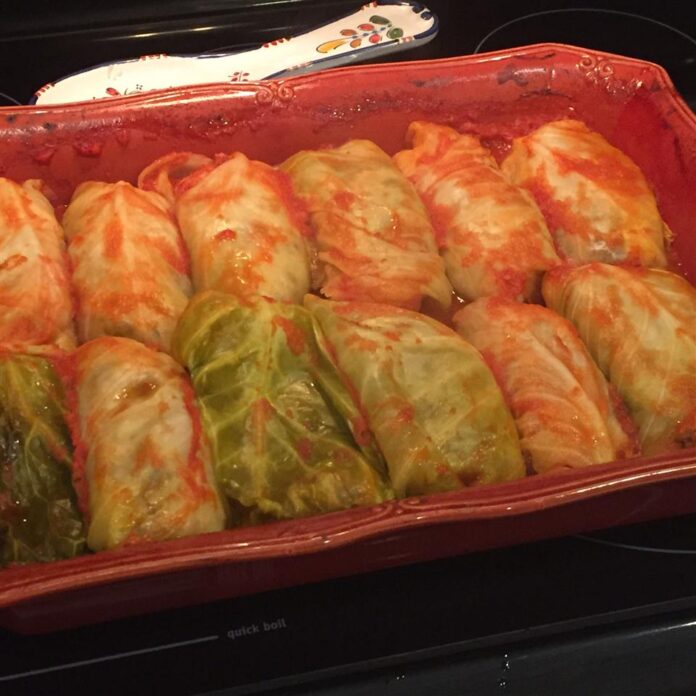
It’s an International Dish
The Lithuanian website alkas.lt recently published an article about cabbage rolls, offering a new take on sauces for the tasty meat and rice mix bundled in cabbage leaves. Children often hate the texture of the cabbage, and meat and potatoes people (men) usually dislike the cabbage part, but they are certainly a mainstay of many Eastern European cuisines, and have cousins in other cultures as well, such as Scandinavia, Austria, Italy and Greece. Their origin is up for debate, but the variations are certainly interesting.
Jewish cabbage rolls (called holishkls, a concoction of ground beef, rice and raisins enveloped in cabbage leaves and simmered in a sauce of brown sugar, lemon and tomatoes) have been traced back 2,000 years to Eastern Europe. They were served in celebration of the fall festival, particularly Simchat Torah, which marks a new Torah cycle. The dish is believed to have originated in the ancient Middle East where it spread to Eastern Europe as trade routes flourished and various ethnic groups migrated.
Cabbage rolls came into Scandinavian cuisine when Sweden’s King Charles XII brought the recipe back to his homeland after fleeing to Moldavia in the Ottoman Empire in the early 18th century on a military mission. Today the Swedes celebrate Kåldolmens dag (Day of the Cabbage Roll) in late November to commemorate the anniversary of King Charles’ death, serving the Kåldolmar delight with boiled potatoes and lingonberry jam.
Romanian sarmale combines ground pork, caramelized onions and rice nestled in a pickled sauerkraut leaf, and then smothered in dill and tomato sauce. It is often topped with bacon or smoked sausage. Poland’s golabki, translating to “little pigeon feet” (named after the French dish that wrapped cabbage around cooked pigeon), stuffs the leaves with pork, beef, rice or barley, accompanied by sour cream and sweet paprika.
Ukrainian holubtsi are typically vegetarian, filling pickled cabbage leaves with either buckwheat and wild mushrooms or a mixture of whole grains and root vegetables, braised in tomato juice or vegetable stock served with perogies. Egyptian mahshi kromb are simmered in an aromatic tomato-based sauce with mint, cumin and other Middle Eastern herbs and spices.
The Asian variation wraps Chinese cabbage around seafood blends, tofu and shiitake mushrooms. Greeks call them lahanodolmades and serve them with a lemon sauce. Dolmades are smaller, made of grapevine leaves stuffed with a rice mixture. Italians add Parmesan cheese to the mixture and serve it with homemade tomato sauce.
Experts say that cabbage leaves provide a powerhouse of antioxidants (especially Vitamin C) to help ward off breast, colon and prostate cancers, reduce “bad cholesterol,” and amp up immunity. Containing many B vitamins and potassium, cabbage boosts energy and calms nerves, while stabilizing heart rate and blood pressure.
Some cooks use Savoy cabbage, others the tighter winter cabbages. The tried and true method of preparing cabbage for rolls is to boil the whole head (with core removed) in a large pot of boiling water until the leaves soften and come away easily. It is said that freezing a whole cabbage first can shorten the cooking time, and the microwave can be used as well, putting the cabbage core side down in a container with ½ cup of water and cooking it on high for 20 minutes, flipping it over after the first 10 minutes.
Most recipes include rice in the meat mixture, which is the same as we use for meatloaf or hamburgers – i.e., can be beef or pork or a combination, with the addition of egg, sautéd chopped onion, salt, pepper and any other flavourings of choice such as dill, parsley and spices.
There is no short cut for the method, which may need a calming dose of wine for the cook, because it can become tedious and sloppy with the trimming of the cabbage ribs, forming the mixture to fit each leaf, rolling them and inserting slippery toothpicks to keep the rolls closed. The results, however are worth the work, because usually you can make several meals’ worth at one time and freeze them.
In our family, the finished rolls were put into a heavy pot or roasting pan with extra cabbage leaves on the bottom, and topped with sauce, tomato or mushroom soup, or a combination. Because of course the gravy is key, when served with potatoes, sour cream and dill pickles.
A typical Lithuanian sauce is made with mushrooms, as in this recipe, which can be adapted to taste:
Mushroom Sauce
2 tbsp butter
½ tsp olive oil
12 oz chopped mushrooms of choice
salt and pepper to taste
1-2 tsp chopped garlic
1 cup broth
1 cup cream
½ cup grated parmesan
2 tsp fresh thyme
Melt butter in a fairly deep pan and sauté onions and garlic until golden, then add chopped mushrooms. Cook for a few minues then add salt and pepper, broth and cream, simmer until the sauce thickens and then add grated cheese and thyme. Pour over prepared cabbage rolls and cover tightly before baking in a preheated 350oF (175o C) oven for 2 hours.





























